Introduction
MPER, or Multi-Purpose Exploration Rover, is SKN SpaceCoffee's longest-running engineering and programming project to date, launched in 2023. It is also the first original and fully-fledged project on which our club has begun work. We invite you to learn more about the rover developed by SpaceCoffee.
Robotic messengers
Ever since we came into this world, people have been trying to learn as much as possible about it and the rules that govern it. Just yesterday, we were discovering new islands and continents, and today, robotic messengers are visiting foreign planets and moons. These unmanned, autonomous vehicles—rovers—have been designed to explore alien celestial bodies and hard-to-reach areas. Their main mission is to study these places: collecting specimens and gathering invaluable data about the conditions there. This research is a significant step toward expanding our knowledge of space and planets, as well as exploring the possibilities of space colonization and the creation of scientific space bases. The numerous reports of many ongoing and planned missions involving rovers inspired us to build our own.
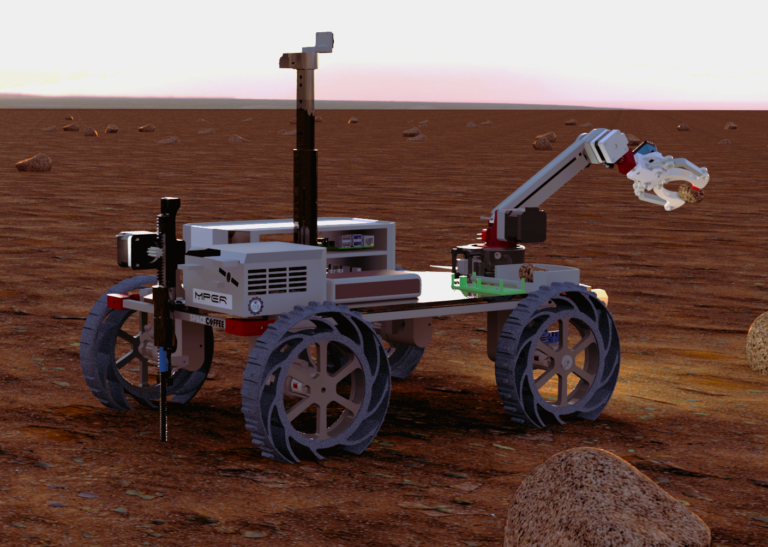
Project goals and objectives
Planned set of rover functions
- Remote task control and semi-autonomous navigation using a user interface created during the project, communication via 2.4 GHz/5 GHz Wi-Fi.
- The possibility of precise manipulation, which will be possible thanks to the developed robotic arm with a manipulator module.
- Sampling from and beneath the surface thanks to a fully developed, effective drilling and storage module; capacity to store up to 5 samples.
- Achieving research objectives—made possible by the implementation of environmental sensors to study soil composition, atmosphere, and radiation detection, along with a system for weighing collected samples.
- The rover is equipped with three cameras: a wide-angle camera, a medium-angle night vision camera, and a camera for object recognition using AI. The wide-angle camera can rotate vertically or horizontally using a servomotor.
- Driving on a slope with an incline of up to 30 degrees.
- A customized LIDAR system has been developed, which forms the basis for the rover's autonomous navigation.
- A path planning algorithm is to be implemented, allowing the rover to move autonomously across the terrain using GNSS, visual markers, and obstacle sensors.
- Use of current consumption sensors that collect diagnostic data from the rover modules.
The rover design called for a cheap-to-build and easy-to-replicate construction solution, which led us to propose the following dimensions: weight below 18 kg and platform dimensions of 700x450x300 mm. The simplicity of our rover allows for the parallel operation and control of many smaller vehicles of this type, which reduces the risk of failure of a single robot, on which the success of the entire mission depends, during more complex operational tasks. In addition, a large area can be explored by many smaller rovers. The mission concept we had in mind includes a main immobile lander—a scientific laboratory—with a fleet of dozens of rovers and drones of various sizes and functionalities, preparing and delivering samples there.
Modules and their implementation
When designing our vehicle, all elements necessary for its operation were taken into account. For this reason, the components have been divided into the following modules and corresponding systems:
- Mobile platform—chassis: the drive system is designed to adapt the rover to uneven and demanding planetary surfaces, thanks to a 4-wheel drive with a shock absorption system that gives it additional agility in hard-to-reach or difficult-to-navigate areas.
- Robotic arm and manipulator with gripper: the component must enable precise interaction with the environment; the manipulator arm has 4 degrees of freedom and five joints, in which we used a designed combination of 2 types of gears – stepped-planetary gears, entirely printed from PETG. This allows us to easily experiment with the arm's parameters so that we can determine the best design for its construction. The rover can collect materials from the surrounding surfaces and transfer them to its platform, which is equipped with a scale for preliminary determination of sample parameters.
- The entire arm is lightweight, has 4DOF, and uses 3 stepper motors and 2 servos for precise motion navigation. Its maximum payload is planned to be 1 kg.
- Sample storage system: we have developed a smart container system—a single force sensor for the front chamber and a second single sensor at the rear for deep borehole samples. The placement of a sample is recorded and the weight is calculated based on the difference in the total weight of the module, with an accuracy of +/- 0.5 g, using a single weight sensor. This allows multiple samples to be stored without the use of multiple weight sensors. The deep borehole sample storage compartment features a rotating container exchange system and also has the option of sequential emptying using a single servo mechanism to rotate the compartment. The front cargo compartment is suitable for storing rocks or other objects collected by the rover, as well as for storing basic tools that can be used by the manipulator. It also contains an ionizing radiation sensor, as part of the environmental sensor module (for atmospheric research), and a mass sensor.
- Drilling system: module responsible for soil sampling. The current planned depth for drill immersion is up to 20 cm below the surface. The latest design of the system includes a stepper motor moving the carriage along a V-slot guide, with a stop at the top. The torque of the stepper motor is increased by our custom gearbox.
- The guide is divided into two parts – a fixed part and a movable part. The fixed part provides mechanical support and acts as a linear bearing, while the movable part is attached to the trolley and fits snugly against the drill bit, allowing soil samples to move upward, as shown in the drilling system diagrams.
- Sampling system: consists of two other modules: a manipulator and a drilling system. The front cargo compartment is within reach of the robot arm. After collection, samples can be transported and stored in prepared containers using the manipulator. This requires taking into account their particular fragility and ensuring prior sterilization of the container. The drill rotates along the guide, allowing the sample to be moved upward toward the sample storage system.
- Main computer and subsystems computers: responsible for coordinating the entire rover. Transfer of information and commands between the subsystems takes place over SPI buses connected to the rover's main computer. We have developed 3 distinct PCB’s for the main subsystems: Chassis, Manipulator and Sampler, all three driven by an independent microcontroller (Arduino Nano), receiving and sending data to the main controller (Raspberry Pi 5).
- Envorinmental Sensors Module: used for the research of environmental conditions prevailing on planets other than Earth were the collection of sensors meant for separate examinations of the atmosphere and the soil. For the aim of analyzing the atmospheric factors, we completed an Arduino Nano-based system of pressure, temperature, humidity and CO2 sensors.
- Additionally, our rover is equipped with an ionizing radiation sensor, placed next to the front cargo compartment. It can be used to measure background radiation and solar storms, and also detect radioactivity of objects picked up by the rover.
- The examination of factors related to soil conditions will be possible due to use of humidity and temperature probes.
- The listed above factors are needed for assessing the elements of a planet’s nature, evaluating its habitability and, for example, crop harvest ability. Measurements prepared during the study of the sample are transmitted from the sensory modules through an UART bus to the Raspberry Pi 5-based main computer. The noted values are then sent to the ground base for the conduct of further research. An important addition in the works is a UV radiation sensor.
- Intuitive UI: Full control of the rover can be achieved in browser, with live telemetry and view. We are developing a pathing system where the operator can tap on a point in view of the rover, and the rover will drive there, avoiding obstacles along the way. The user interface can be accessed by browser on any PC or mobile device, allowing intuitive control of the vehicle.
- Custom-built LIDAR-like system – consisting of a two DOF laser sensor “turret”, which can point at any object and return its distance from the rover.
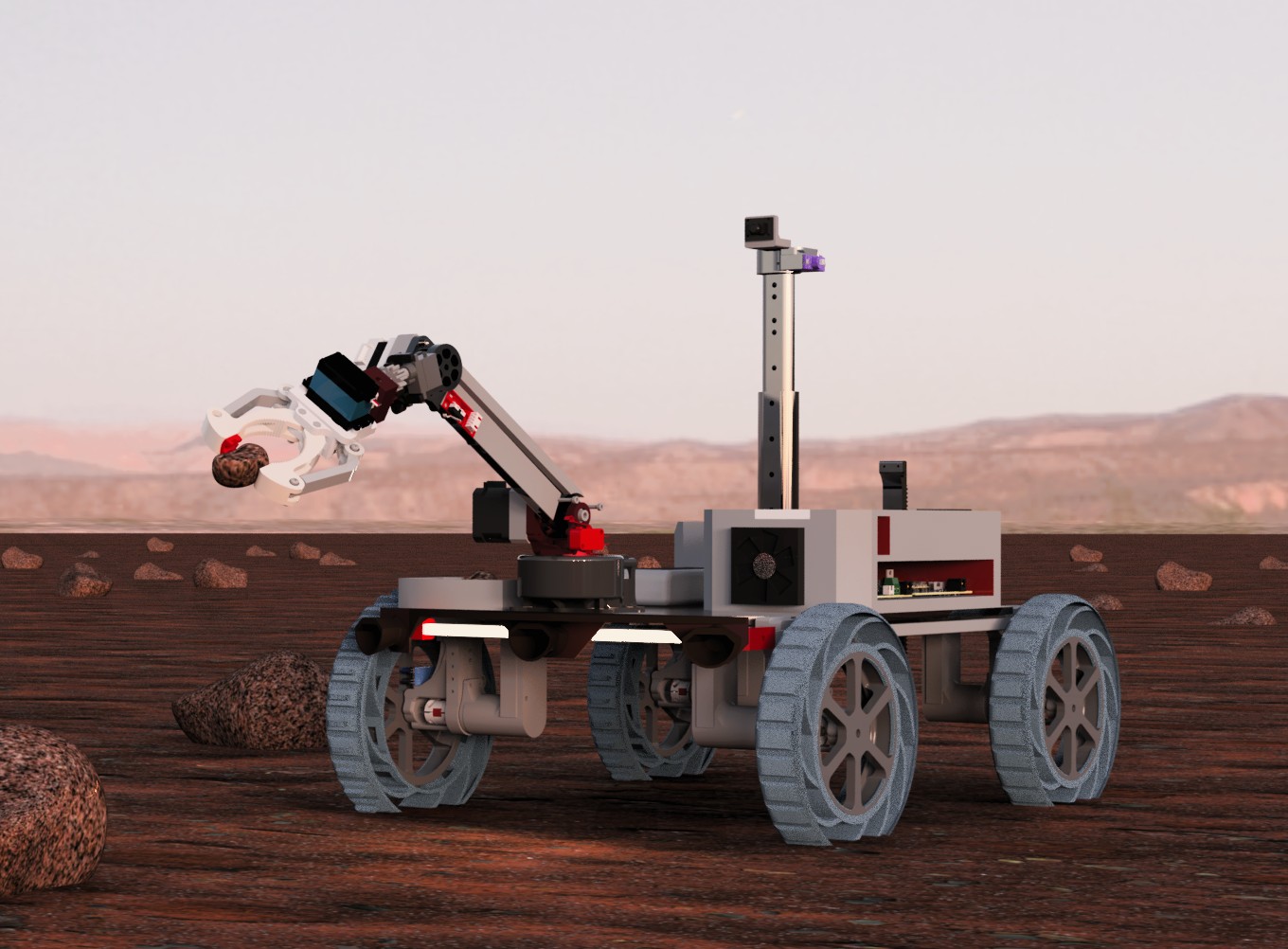

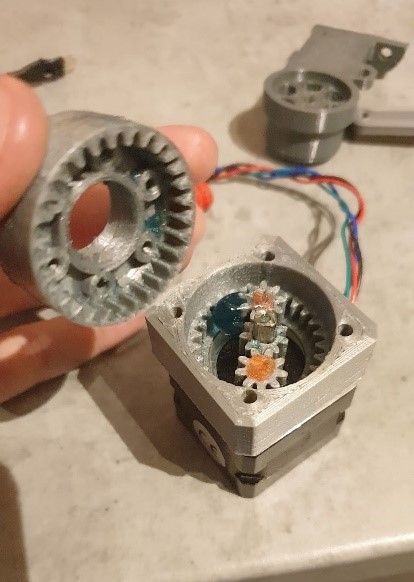

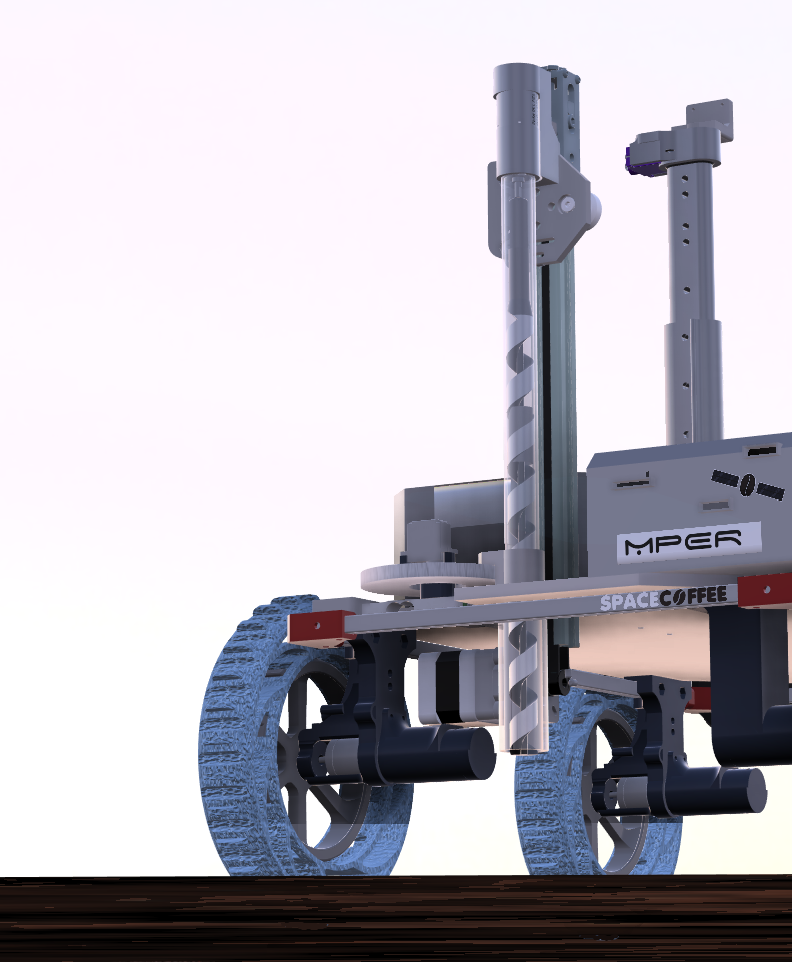
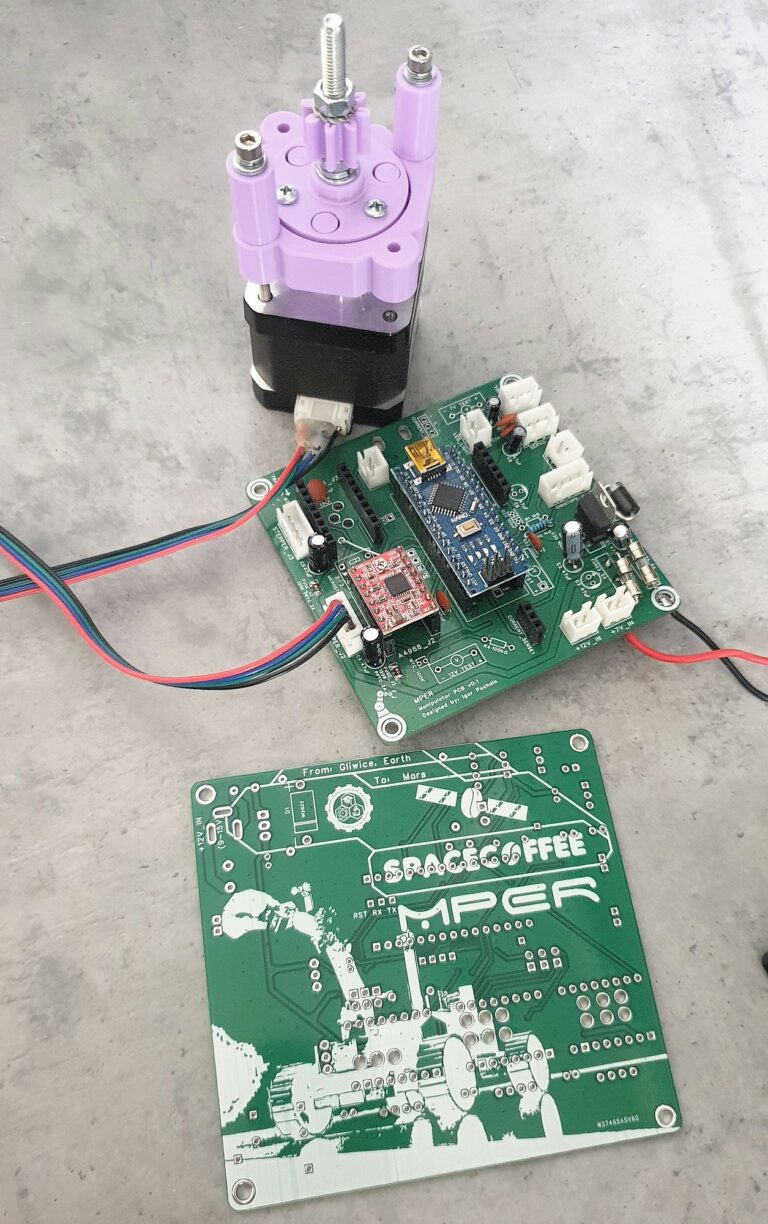


Developments: posts related to the MPER project
Summary of the 9th Silesian Science Festival
Wczoraj, bo 8 grudnia, zamknęliśmy tegoroczną edycję Śląskiego Festiwalu Nauki—już dziewiątą! Cóż to był za czas! Śląski Festiwal Nauki to największe w Polsce popularnonaukowe wydarzenie, przepełnione wykładami, warsztatami, eksperymentami i pokazami o najróżniejszej tematyce — nawiązującej zarazem do wszelkich nauk ścisłych, jak również do sztuki, historii i ekonomii. Podczas wydarzenia goście mieli okazję spotkać osobistości…
"Projekt Politechnika" Conference, Fall 2025
On October 21, 2025, members of the SpaceCoffee Student Research Group presented the results of their projects, carried out at the Silesian University of Technology as part of the PBL program for high schools. Some of the project presenters are already graduates of the Academic High School of the Silesian University of Technology, who, thanks to the initiatives offered by the University, decided to continue their education at this very institution. The exhibiting students took the opportunity to present...
Sample collection and containment system for a compact planetary exploration rover
Title: Sample collection and containment system for a compact planetary exploration rover Authors: Maja Rudnicka, Michał Lasak, Igor Puchała, Piotr Bartosz, Dominik Bereta, Dariusz Myszor Conference: International Students Scientific Conference TalentDetector2024_Summer Abstract: The purpose of this research is to develop an exploration rover to use in Earth and Martian-like environments, which requires the development of…
Development of the MPER project (2023)
The improvements achieved during this year's work on the rover have resulted in the implementation of an impressive number of planned features and components. Our work focused on: — Completing the design of an integrated circuit on a PCB board. — Modernizing the chassis of our rover, based on conclusions drawn from testing the previous module. The chassis currently in use is designed for the construction of a full-size structure. — Designing, manufacturing components, installation...
MPER at the “Projekt Politechnika” Conference
The rover development team from our Club presented MPER at the PBL high school project conference organized by the Silesian University of Technology. They demonstrated both the current rover model and a poster summarizing their work on the project. Poster prepared for the MPER Conference during the presentation at the “Politechnika Project” Conference.
Future potential developments
The main two solutions viewed as future extensions of the rover are: current consumption diagnostics, for which we plan to utilize 5 current consumption sensors—their use includes measuring forces of the manipulator's gripper and joints, as well as sample drill movement. It also allows for drivetrain diagnostics and estimation of time left until the battery is discharged. The second extension is the use of solar panels as part of the Power Supply Module. A design of a collapsible solar array, for preserving the rover's mobility and stability when not charging, is possible.